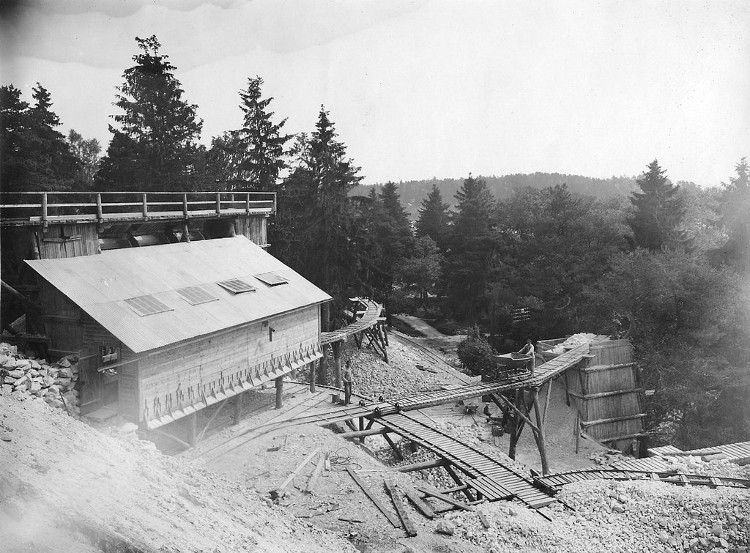The village is considered the
Four out of the ten extremely rare elements of the planet have been found in this village and therefore people are not afraid to say that this is the "capital" of rare substances.
In the periodic table, there are ten substances, Yttrium, Ytterbium, Terbium, Erbium, Gadolinium, Thulium, Scandium, Holmium, Dysprosium, Lutetium all possess a common characteristic.
They are all found from a single piece of stone ore excavated in an old metal mine in a small village called Ytterby located on the island of Resarö (Sweden).
All of these chemicals are very rare and extremely difficult to extract. Scientists and chemists have spent tens of years discovering and studying that whole number. In it, at least 4 elements have been named after the village of Yttrium (Y), Erbium (Er), Terbium (Tb), and Ytterbium (Yb).

At Sweden's Resarö island, the humble Ytterby village possesses an incredible amount of rare substances.
History registered the tiny Swedish village of Ytterby for the first time in 1787, when a military lieutenant and chemist Carl Axel Arrhenius discovered an unusually heavy form of black ore in an old quarry. near the village.
Arrenhus named this ore sample Ytterbite and sent it to many other chemists for analysis, hoping it is a new material discovered similar to tungsten.
Johan Gadolin, a Finnish chemist at Åbo University, identified the first rare element from Arrhenius' rock form in 1789. This element was called Yttrium (Y). In more than 100 later, 9 elements have been found from each of these rock samples.
In 1843 Carl Gustav Mosander discovered that Ytterbite was actually a mixture of three metal oxides. Since then, two new elements have been extracted - that are Terbium (Tb) and Erbium (Er) - both are named after the village of Ytterby where they were found.
By 1878, the fourth metal oxide sample was discovered by Jean Charles Galissard de Marignac, from which the pure Ytterbium (Yb) element was separated.
Gradually, the separation techniques improved, many new elements continued to be found among the above 4 oxides, bringing the total number of elements extracted from the Ytterbite rock sample to ten.

The Ytterby mine, where the ore sample was excavated, now has only one plate left to save history.
Interestingly, one of these elements, Gadolinium (Gd) was named after Johan Gadolin. Even the stone model was renamed from Ytterbite to Gadolinite to honor the merit of the scientist.
The ore mine where the rock sample was mined was actually a feldspar mine , but was closed long ago, and is now covered by weedy plants. Only a small board on a stone near the mine left a trace of the discovery.
The discovery was of great significance, even some of the roads in the village were named after the elements found here.
Yttrium (Y), the first rare earth element discovered by Johan Gadolin, has been widely used in LEDs and phosphorus, typically red phosphorus in cathodic tube lamps used to project images inside. TV head.
Yttrium is also used to produce electrodes, electrolytes, electronic filters, lasers, superconductors, and many other medical applications.

A road is named after the substance Terbium found in the legendary rock form.
Terbim (Tb) is used for semiconductors to produce semiconductor electronic devices such as memory cards, switches . but most of this supply in the world is used in the production of green phosphorus. available in the television screen.
Terbium is also used in fluorescent lamps, and in actuators of submarine detection systems or sensors.
Erbium (Er) has many optical applications such as laser production and image amplification devices. Erbium lasers have a low penetration capacity that allows them to be used in the skin and dental care industry, in which only the skin and outer surfaces of the teeth are treated.
Ytterbium (Yb) is used primarily as a stimulant of stainless steel, but its most interesting application is in atomic clocks. The Ytterbium clock has a deviation of less than 2 parts per billion billion, which is thought to be more accurate than the cesium atomic clocks - commonly used to measure seconds.
In such an important sense, the tiny Ytterby village has become the only place on the planet that has the most amount of substances in the periodic table. Perhaps because of that, someone likened it to the most favorite chemist.
- The cleanest village in the world - Where women own
- The unique villages in the world
- 15 villages as beautiful as fairy tales
- Chu Cat Bagua village and Khong Minh's
- The secret of the strange village where for 50 years no children were born
- Mysterious and strange village story people do not dare to wear shoes
- Mysterious village of 2,000 people suddenly
- Traces the 2,300-year-old village
- The 'cursed' village caused people to 'evaporate'
- Makhunik - controversial village about the presence of
- Strangely, the village did not produce a boy in Poland for nine consecutive years
- The village no one dared to mention the name for fear
 'Fine laughs' - Scary and painful torture in ancient times
'Fine laughs' - Scary and painful torture in ancient times The sequence of numbers 142857 of the Egyptian pyramids is known as the strangest number in the world - Why?
The sequence of numbers 142857 of the Egyptian pyramids is known as the strangest number in the world - Why? History of the iron
History of the iron What is alum?
What is alum?